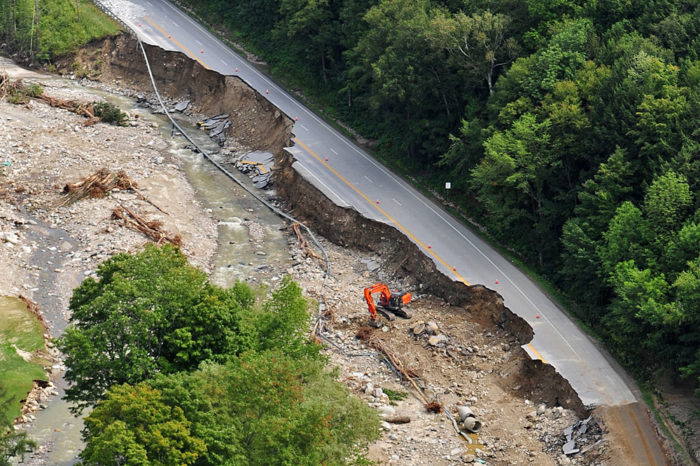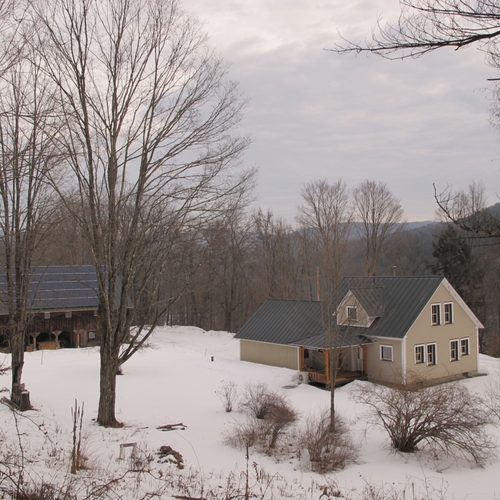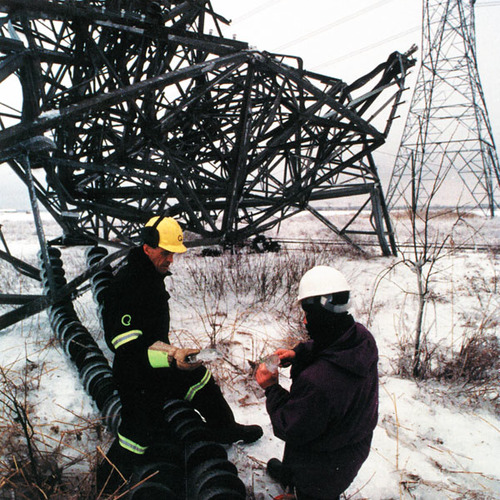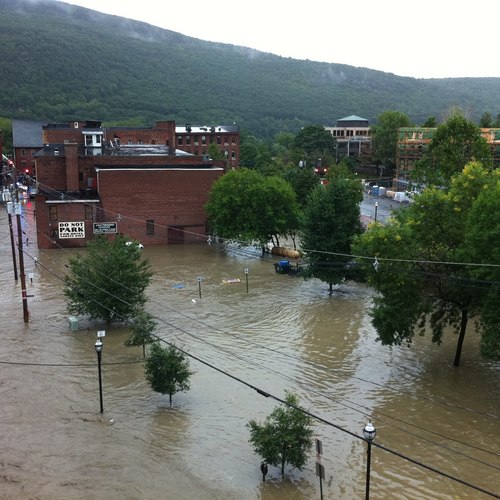Image Credit: Lars Gange and Mansfield Heliflight
Image Credit: Lars Gange and Mansfield Heliflight Hurricane strapping and components for providing a continuous structural connection between foundation and roof.
Image Credit: Simpson StrongTie Getting ready to pour a concrete ceiling on a modular safe room in Sioux City, Iowa.
Image Credit: Dave Gatley, FEMA
Anyone who was in Vermont in late August of this year and witnessed the raging floodwaters from tropical storm Irene gained an intimate view of the vulnerabilities we face from intense storms and flooding. Hundreds of miles of roadway were heavily damaged, dozens of bridges washed away, and some communities were cut off for weeks.
Vermont is not alone. Throughout the Northeast, there was a 67% increase in heavy rainfall events (defined as the heaviest 1% of all rainfall events) from 1958 to 2007, according to the multi-agency U.S. Global Change Research Program.
Climate scientists tell us to get used to it
As the planet warms over the coming decades, precipitation will increase overall — due to greater evaporation from bodies of water and, thus, more water vapor in the atmosphere — though there will be significant regional variation. Even in areas that see a drop in precipitation (an expected trend in much of the western U.S., for example), the rain that does fall is expected to increasingly fall in deluges. So, we need to prepare for more Hurricane Irenes and the resultant flooding.
Along with more intense rainfall events, we can expect stronger winds. Some of these winds will be from tropical storms whose intensity is magnified as their air masses pass over a warmer South Atlantic and Gulf of Mexico. Others of the winds will be more localized thunderstorms that result from air masses over land warming and rising into intense cumulonimbus clouds.
In coastal areas, sea level rise will play into this, as coastal storms increasingly cause storm surges — the situation that befell New Orleans in 2005 with Hurricane Katrina. Even a few inches of sea level rise dramatically increases vulnerability to storm surges. How quickly sea levels will rise depends on the ice mass on Greenland, and scientists are far more worried about this than they were just a few short years ago.
Resilient design
The bottom line is that we need to change the way we build our houses and design our communities to protect us from such storms. This is an important part of resilient design — which is the subject of this and the series of blogs that will follow.
There are a lot of strategies that come into play with storm-resistant construction. A few of these are described below.
Building to stringent hurricane standards
In designing homes that will hold up well in strong winds, we should borrow heavily from he Miami-Dade County Building Code, which includes a wide range of provisions, including hurricane tie-down strapping or clips that provide a continuous structural connection from foundation slab to roof, minimum 2×6 framing in exterior walls, minimum 19/32-inch plywood roof sheathing with 6-inch nail spacing at panel edges and 4-inch at gable ends, and hurricane-rated shingles. Other wind-resistant strategies include hip roofs that deflect winds, avoidance of deeply overhung entryways, and outward-opening doors that are held more tightly closed in heavy wind.
Note that some measures for ensuring structural integrity in intense wind events conflict with strategies to improve energy performance or reduce resource use. The Miami-Dade County Hurricane Code, for example, calls for 16-inch on-center 2×6 exterior wall framing, double top plates, and corners comprised of a minimum of three studs — measures in direct opposition to advanced framing.
Control of wind-driven rain
Adequate overhangs are key to keeping rain away from homes. I like at least 24-inch-deep overhangs, in some cases even more. Gutters are advisable to capture rainwater, with downspouts and horizontal lines to carry collected water away from the house.
Basement drainage should include continuous perimeter drains that extend to the bottom of the footings. Foundation walls or the slab edge (with slab-on-grade construction) should be coated with a dampproofing layer, covered with a foundation drainage board, and backfilled with free-draining crushed stone. The perimeter drains should drain to daylight if topography permits. And the ground surface should slope away from the house.
Walls should be designed with rainscreen detailing that allows trapped moisture to escape and provides a pressure break for wind-driven rain, while allowing any moisture that does penetrate the siding to drain to the base of the wall or evaporate and escape. With an adequate overhang, the siding won’t even get wet with most storms.
Control of stormwater
More intense rainfall events will mean greater volumes of runoff, or stormwater flow. This means we should be installing larger-diameter storm sewers and culverts. It also means that we need to do everything we can to provide for infiltration of rainwater where it falls — so that we don’t need to transport that water at all.
The latter can be accomplished by minimizing impermeable surfaces, providing infiltration trenches (filled with crushed stone) between adjacent impermeable surfaces such as sidewalk and driveway, installing permeable pavement, avoiding curbs along driveways and roads, and providing grassy swales and infiltration basins that allow runoff to spread out and soak into the ground.
Along any waterways, we need to consider erosion risk. As we saw so clearly with tropical storm Irene in Vermont, intense rainfall events — particularly if the ground starts out nearly saturated — can result in streams and rivers quickly overflowing their banks. We need to provide for this in our placement of homes and outbuildings. The right plantings can help to stabilize banks and resist erosion.
Safe rooms
In parts of the country where tornadoes and hurricanes are most common, we should consider installing safe rooms to provide a safe haven in an extreme wind event. These are small bunkers in our homes or garages, anchored to concrete slabs and typically built of reinforced masonry block with steel-beam roofs.
Such rooms are typically not connected to the walls of the house, and they should be equipped with battery-powered or wind-up radios, flashlights, etc. Excellent information on safe room design and construction is available from FEMA.
— — —
In this resilient design series, I’m covering how to improve the resilience of our homes and communities, including strategies that help us function well in the aftermath of a major storm or event that results in lost power, interruptions in heating fuel, or water shortages. We’ll see that resilient design is a life-safety issue that is critical for the security and wellbeing of families in a future of climate uncertainty and ever-present risk of terrorism.
Alex is founder of BuildingGreen, Inc. and executive editor of Environmental Building News. To keep up with his latest articles and musings, you can sign up for his Twitter feed.
Weekly Newsletter
Get building science and energy efficiency advice, plus special offers, in your inbox.
















3 Comments
New design potentials?
Alex,
I'm a big fan of large overhangs for weather, energy and comfort. Is the overhang issue due to uplift damage? Would it make sense to think of breakaway methods that can reduce drag in these limited events rather than give up the overhang altogether?
Uplift with deep overhangs
Yes, it's an issue of uplift. I'm not sure how break-away design would help, since the overhang is usually the roof edge. I'm not willing to give up a deep overhang either, so I think the solution is to overbuild somewhat--which may mean giving up on advanced framing, or going with more robust trusses or rafters. Unfortunately, more wind-resistant construction (for resilience) means compromising on some of the green features. In my book, durability (deep overhang) takes priority over resource efficiency (advanced framing).
Perhaps fumbling in the dark.
Alex, I was thinking that with the advent or raised heel trusses this can/does creat a situation where the overhang is an add on to a wall face even when the roof continues. It would be interesting to look at the joint between wall and roof as "breakable". One that is designed to handle downward loads but where the roof sheeting could come off the framing at wind loads prior to the rest of the structure giving way.
Gee... Perhaps its best to not let that stuff breakaway....I don't like the idea of roof sheeting flying through the air in hurricane forces. Not a nice scenario!
Log in or create an account to post a comment.
Sign up Log in